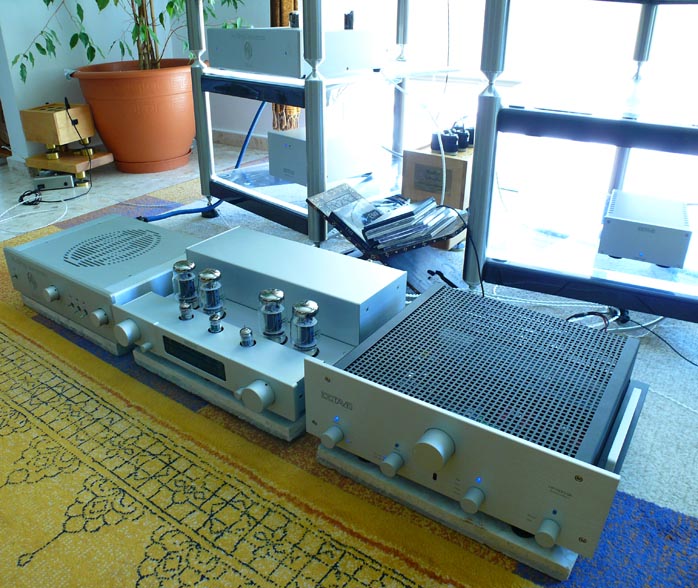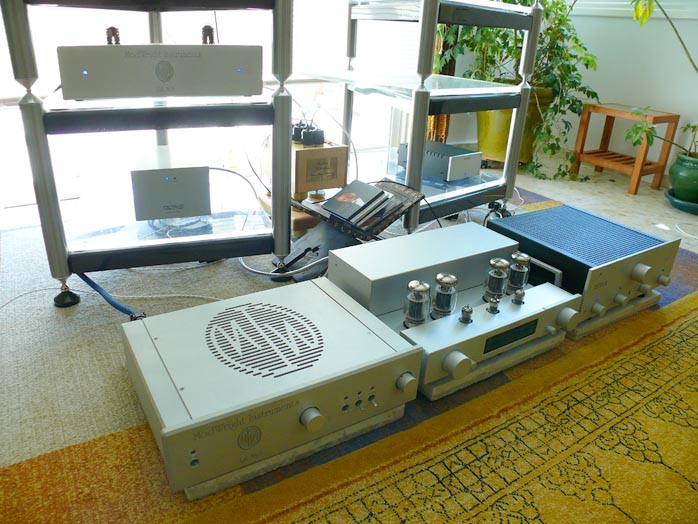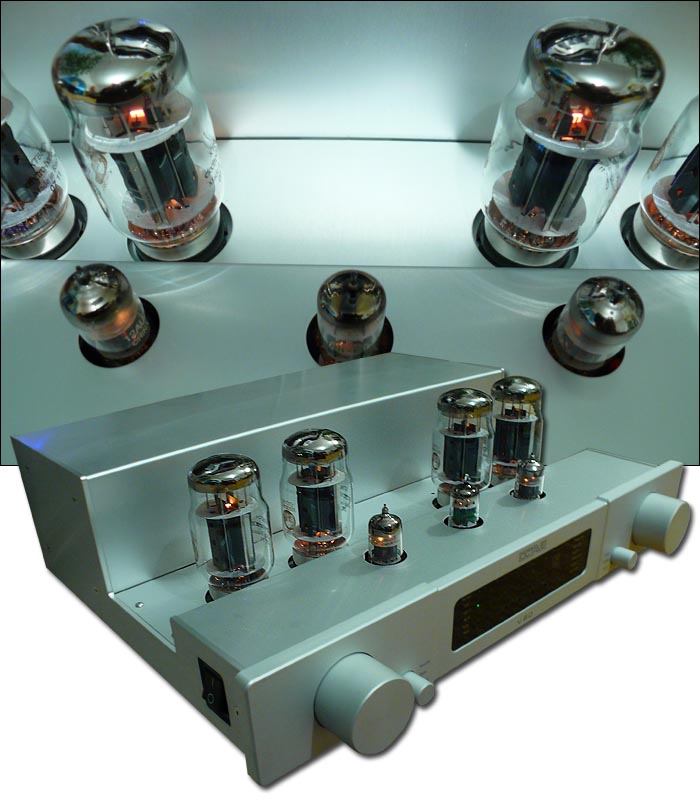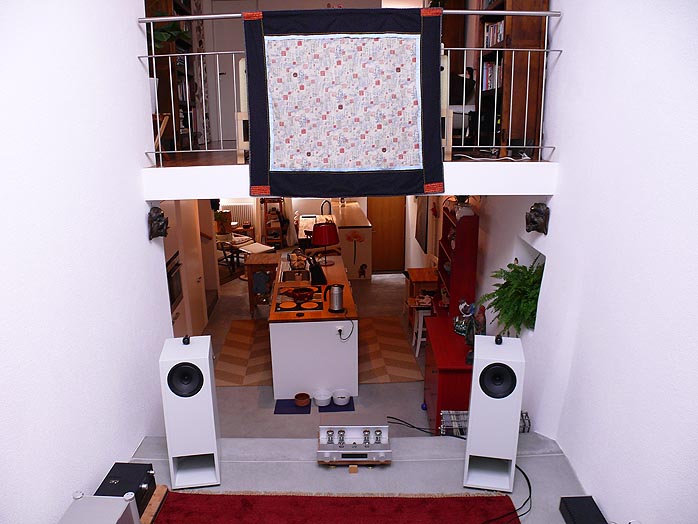|
This review page is supported in part by the sponsors whose ad banners are displayed below
|
|||||||||||||||
 |
|||||||||||||||
Esoteric's A-100 and Octave's V80 proved classic studies in upper-crustacean equality. That's a humorous way of saying that as things get better and better and better, gross differences dissolve. Yet distinctions remain. The inherent purity assured by low distortion, low noise, wide bandwidth, ample power reserves and overall circuit stability helps to crystallize the remaining aroma of THD distribution. Instead of getting stuck in fuzziness and blur from 2nd-order distortion overload; or hammered by unnatural sharpness from runaway odd-order distortion effects; one is left with see-thru transparency. It's in this transparency that the circuit's inherent (low) harmonic distortion signature remains distinctive; easy to hear, a pure flavor distillation rather than a bothersome distraction you'd call distortion. Core stuff. Though a push/pull amp, the Esoteric's treble is distinctly zero-feedback single-ended in gestalt - supremely elegant, a bit sweet and with the fire toned down. The amp's overall tonality is 2nd order to the Octave's 3rd, i.e. minorly euphonic in effect. Another way of saying the same is triode versus pentode. What it means to the listener is that the V80 conveys more bite and heat on accelerated transients; separates out deeper during complex passages; and resolves lower in the depth/layering domain. Female power belters walking the edge will benefit from the A-100's prettifying smoothing action if that's your leaning. The V80's greater honesty will bare the same edge without defaulting to sizzle. |
|||||||||||||||
 |
|||||||||||||||
Here language can confuse intended meaning. Music's transient nature is angular. It's edgy by nature, a far cry from ocean pebbles rounded over by aeons of water works. It's when the inherent edginess of music elicits a self-protective reflex in the listener -- a need to turn the volume down; discomfort; feeling assaulted -- that something has gone awry. Etchiness. So it makes sense to say that the V80 accompanies the listener deeper and further down into these angular and pungent aspects than the A-100. But the Octave sound is free of that artificial etchiness we all love to hate. For a bit of cunning linguistics, consider the harshness of tch in etchiness versus the softer dg of edginess. It's even in the spelling that one can find the vital distinction between realistic spunk and hyped nervousness. Dominated as it's been by zero NFB single-endeds, in my tube amp experience the V80 became an unexpected first in how, by operating at the same level of overall transparency as superior SETs, it let me hear the "3rd-order pentode" aroma in a very pure distilled fashion. Stripped of all the outright or more subliminal blurriness and fattiness of lesser valve push/pull circuits, what remained was a slightly blueish tone color I'd not characterize as inherently cool as might be assumed. The whole business of attempting to characterize an amplifier's tone signature was once again down to the level where Nelson Pass' FirstWatt amps F3 thru F5 roam these days. Water-like purity carries just a hint of aromatic infusion, presumably the light footprints of the output devices. |
|||||||||||||||
 |
Where the V80 is superior rather than simply different to the A-100 is in low-impedance load invariability, ascertained by my Mark & Daniel Maximus Monitors plus OmniHarmonizer, irreverently referred to as 'those loads from hell for tubes' around here. 85dB, 4-ohm, capable of mindboggling bass (extension, weight and punch all together), they sound sleepy, ponderous, overdone, boomy, loose -- or bright and forward -- when amplification isn't up to snuff. The necessary snuff consists of low output impedance aka damping factor, high current control and very good upper midrange/ lower treble linearity. Otherwise, the air motion transformers' power response takes the lead. |
||||||||||||||
| While the A-100 had no issues playing louder than desired, low bass even on the 4-ohm taps was a bit underdamped, bloomy and with excess amplitude. This led me to suspect low feedback, high-ish output impedance and rising THD into this load where increased harmonic distortion in the bass equalled higher perceived loudness at the cost of less separation and | |||||||||||||||
| articulation. Be it the V80's greater power, lower output impedance, higher current... the net effect was simply perfect performance on the mighty Maximus. Bass was exceptionally well controlled and extended. As with the A-100, the presence region exhibited zero forwardness or excess energy. This proved that the '3rd-order pentode' aroma wasn't inherently misbehaved or aggravating in the 1-4kHz band. I could run the omnidirectional ambience tweeters fully open, a sure sign that the V80 was admirably linear and low distortion in this hyper-critical area. |
|||||||||||||||
|
| |||||||||||||||
In my speaker stable, the Maximus has always been more of a work horse you pull out to torture amplifiers with. Calling it a high-maintenance babe hits the same groove. I've always respected the speaker for its nearly unnatural full-range performance potential. Yet potential also hints at that I've rarely heard all of it come together for real enthusiasm over mere respect. "If I could just hear these buggers with tubes." The V80, just as claimed by its maker, proved super robust into this load to leave absolutely nothing under the table. How this control and willingness to take on the secrets in the bassment translated when the load-control challenge was lightened, my DeVore Fidelity Nines demonstrated. |
|||||||||||||||
 |
|||||||||||||||
This is a deceptive speaker. Its 2 x 6" artillery won't prepare those in sane-sized rooms for the bass articulation and extension it is capable of. The 3/4" soft dome tweeter meanwhile is solidly good to 40kHz and in the designer's opinion the equal of ribbons while being more seamlessly matched to his chosen dynamic midrange. "Great bass for tubes" remains the limp-wristed compliment valve amps deservedly attract a lot. Not with the V80. If the examples of M&D and DeVore speakers cover a respectable cross section, Octave's best integrated is a true muscle amp in exactly the area the term implies: killer bass. I'm certain this is directly related to Herr Hoffmann's willingness to embrace negative feedback. The amp's exceptionally low noise and apparent linearity in conjunction with the described tone color also mean that it stages and layers like gangbusters. There's no blur or lumpiness to obstruct your vision all the way back into the stage. The amp separates cleanly and deeply. Yet this incisiveness doesn't go overboard. It suggests that higher odd-order artefacts are seriously suppressed and even the third makes only a minor appearance. Vicente Amigo's fiery Flamenco brilliance didn't become too much, didn't prompt a secret desire to smooth over the attacks, to tame the leading edges and overall forward momentum. No relentlessness in other words. No dryness either as anti-feedbackers would believe. |
|||||||||||||||
 |
|||||||||||||||
Returning to the A-100, there was a mild overall softening, a bit looser bass and a less energetic treble just as the 2nd/3rd characterization would predict. Two really great amps, two different flavors. Importantly, the Octave is significantly less expensive and rather more powerful due to fixed bias and pentode mode. As with the A-100 however, addition of a premium preamp nets dividends which, on paper and with the advocates of at best passives, shouldn't exist. Apparent resolution goes up. As do dynamics and soundstage size. Everything firms up and becomes more substantial. How would my ModWright LS/PS 36.5 compare to Octave's preamp? The latter employs solid-state rectification but mimics the ModWright in using transformers to generate true balanced impedance-stabilized outputs. Having already tested the HP 500 SE in the Esoteric C-03/A-100 review, I knew it to be cut from the same cloth as the V80. It's incisive, controlled, well damped, texturally full but tonally blueish rather than golden or silvery. And it has obvious drive that gathered things up and together. Andreas Hoffmann doesn't preach artificial sweeteners but clearly believes in measurable linearity (the owner's manuals have distortion graphs). I predict that those coming from transistors who've always believed the tube camp to be overrun by libertines would instantly embrace the Octave sound. It's not about prettification or undue civility when the material really requires more grit and fortitude. The mean trick accomplished is greater rawness which nonetheless doesn't assault your ears. It's pure like SETs but with more bite and pungent sharpness. |
|||||||||||||||
 |
|||||||||||||||
The main element of distinction between the German and American preamps was that drive and urge (the irrepressible sense of forward momentum) was greater with the Octave. D3A/EF184 pentodes versus 6H30 double triodes? It's natural that one longs to grasp for explanations but in this manner, it's not possible. All I can tell you is that the HP 500 SE sounds spicier than the more relaxed ModWright. If one were to caricaturize sonics into fields like vivid, adrenaline junkie, pipe 'n' slippers, romance and such, the Octave preamp would sit squarely in the first two sectors. The ModWright's bass weight appears greater at first. Upon closer inspection, it's simply how the wirier Octave's yet higher articulation in the same register suggests subjectively less mass. A shift of emphasis. It seems less about raw quantities and more about perception; how our ear/brain adds things up. To fully maximize the Octave sound, the Octave preamp is the better match. What is the Octave sound? |
|||||||||||||||
 |
|||||||||||||||
| It's a bit unique in my experience. Having now heard all of Nelson Pass' FirstWatt solid-state wonders except for the Aleph J, I'm intimately familiar with the designer's core sound of refined, low-power transistor amps (with or without feedback and using quite different circuits). The Octave sound is a blood relative to FirstWatt and thus closer to transistors than tubes. However, a direct A/B shows that the tubes in the Octave machines remain audible contributors. It's down to an obvious fullness that can't readily be pinned on second-order octave doubling. You hear this greater fullness of tone density but what makes it so is harder to define. Suffice to say that the tubes aren't window dressing. They're actively doing something quite important but subversively sly. |
|||||||||||||||
 |
|||||||||||||||
It's not a warm diffusive sound. It's not a big comfy push/pull sound in partial soft focus either. It's highly focused, propulsive, rhythmically tight, honest, rocking, articulated and resolved just like the FirstWatt ultra-low-distortion F5. What it doesn't have is the 'enhanced visibility' of artificial triode intelligence whose unpredictable distortion behavior can perform that peculiar spatial sculpting which the Octave machines do not. Yet Middle-Eastern Pop, Egyptian shaabi and Bulgarian high-speed wedding music -- my Cyprus-inspired poisons to rattle nerves -- doesn't misbehave one bit. |
|||||||||||||||
 |
|||||||||||||||
I concur with the designer that adding capactive storage to the V80 benefits bass tautness for that coiled rebound finesse but does not add mass or weight. Hence it's no substitute for a more endowed speaker as was obvious when I replaced my bass-limited WLM Grand Viola Signature monitors with Haigner's rear-hornloaded Rho two-way. |
|||||||||||||||
 |
|||||||||||||||
The Haigner Rho is a cousin to the Zu Druid with more bandwidth on either end. In trade, dynamic punch is toned down. With Octave's muscle amp handling the leash, I actually had too much upper and mid bass. So I fell back on Haigner's inserts which narrow the forward-firing slot to alter the bass loading. |
|||||||||||||||
 |
|||||||||||||||
Adding it all up: Were it not for its badly fragmented state and present bushman economics, it's difficult to comprehend why the US remains without Octave importer. Based on my two loaner samples, these electronics run 'normal' tubes in worryfree fashion backed by clearly sound engineering. They ace the drive, bass, power, gain and noise hurdles transistor lovers take for granted. They're comprehensively feature-rich and beautifully while not extravagantly built. Return on the euro seems eminently fair as highlighted by the brilliant showing against the far costlier Esoteric amplifier from Japan. The Octave sound is best characterized as transistor man's subtle valve aroma. And based on trade show appearances, Octave tube amps will actually stand in to drive speakers which usually rely on sand amps. But noise performance is so brilliant as to also allow the usual high-eff speakers their day in the sun (though on a whole, they won't need this kind of power). Add fool-proof precision bias anyone capable of checking oil levels in a car can handle. There's not a single complaint I can muster; not one secret "done different" wish to scare up. Clearly, deep-triode fans will retain their focus on direct-heated valves and snub today's pentodes. But solid statesmen and women who've always found something wrong with tubes -- or simply detected no compelling reason to switch -- will fondly embrace the Octave sound as offering everything transistors do while adding a small but elusive something transistors tend to fail at. In short, it's a 70:30 mix I hadn't quite come across before but instantly found exciting and perfectly persuasive. |
|||||||||||||||
 |
|||||||||||||||
| Quality of packing: Exceptional. Reusability of packing: Multiple times. Ease of unpacking/repacking: Easy. Condition of component received: Perfect. Completeness of delivery: Power cords, owner's manuals, spare tube, bias screw driver Quality of owner's manual: Exceptional. Ease of assembly: None required. Tube replacement requires removal of top covers. Website comments: Good. Human interactions: Prompt and forthcoming on all info requested. Pricing: Definite value. Final comments & suggestions: Brilliant implementation of fixed bias which eliminates tube worries. Very nice illuminated remote which arrives preprogrammed. Fully 'thought-out' mature product from a company which clearly understands engineering and has applied it to make tubes stable and easy to use. |
|||||||||||||||
|
| |||||||||||||||
 |
|||||||||||||||
 |
|||||||||||||||
|
Octave website
|
|||||||||||||||
 |
|||||||||||||||